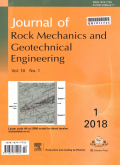- 钛学术文献服务平台 \
- 学术期刊 \
- 基础科学期刊 \
- 天文学、地球科学期刊 \
- 岩石力学与岩土工程学报(英文版)期刊 \
Particle breakage of sand subjected to friction and collision in drum tests
Particle breakage of sand subjected to friction and collision in drum tests
基本信息来源于合作网站,原文需代理用户跳转至来源网站获取
摘要:
This paper presents a laboratory experimental study on particle breakage of sand subjected to friction and collision, by a number of drum tests on granular materials (silica sand No. 3 and ceramic balls) to investigate the characteristics of particle breakage and its effect on the characteristics of grain size distribution of sand. Particle breakage increased in up convexity with increasing duration of drum tests, but increased linearly with increasing number of balls. Particle breakage showed an increase, followed by a decrease while increasing the amount of sand. There may be existence of a characteristic amount of sand causing a maximum particle breakage. Friction tests caused much less particle breakage than collision tests did. Friction and collision resulted in different mechanisms of particle breakage, mainly by abrasion for friction and by splitting for collision. The fines content increased with increasing relative breakage. Particle breakage in the friction tests (abrasion) resulted in a sharper increase but with a smaller total amount of fines content in comparison with that in the collision tests (splitting). For the collision tests, the fines content showed a decrease followed by an increase as the amount of sand increased, whereas it increased in up convexity with increasing number of balls. The characteristic grain sizes D10 and D30 decreased in down convexity with increasing relative breakage, which could be described by a natural exponential function. However, the characteristic grain sizes D50 and D60 decreased linearly while increasing the relative breakage. In addition, the coefficients of uniformity and curvature of sand showed an increase followed by a decrease while increasing the relative breakage.

推荐文章
SAND-Ⅱ解谱的不确定度分析
不确定度
SAND-Ⅱ
蒙特卡罗方法
随机样本:标准偏差
美国Sand Hills地区地下水数值模拟及水量平衡分析
沙丘区
降水入渗补给量
地下水数值模拟
水量平衡分析
Influence Rule of End Face Friction on Static Compressive Strength of Polymer Bonded Explosive (PBX)
高聚物粘接炸药(PBX)、端面摩擦效应、静态压缩、能量守恒方法
荷兰人工育滩工程Sand Motor的经验与启示
补沙引擎
人工育滩
沙滩养护
生态修复
内容分析
关键词云
关键词热度
相关文献总数
(/次)
(/年)
文献信息
| 篇名 | Particle breakage of sand subjected to friction and collision in drum tests | ||
| 来源期刊 | 岩石力学与岩土工程学报(英文版) | 学科 | |
| 关键词 | |||
| 年,卷(期) | 2021,(2) | 所属期刊栏目 | |
| 研究方向 | 页码范围 | 390-400 | |
| 页数 | 11页 | 分类号 | |
| 字数 | 语种 | 英文 | |
| DOI | |||
五维指标
引文网络
引文网络
二级参考文献 (0)
共引文献 (0)
参考文献 (46)
节点文献
引证文献 (0)
同被引文献 (0)
二级引证文献 (0)
1982(1)
- 参考文献(1)
- 二级参考文献(0)
1985(1)
- 参考文献(1)
- 二级参考文献(0)
1996(1)
- 参考文献(1)
- 二级参考文献(0)
1997(2)
- 参考文献(2)
- 二级参考文献(0)
1998(1)
- 参考文献(1)
- 二级参考文献(0)
2000(1)
- 参考文献(1)
- 二级参考文献(0)
2001(1)
- 参考文献(1)
- 二级参考文献(0)
2002(1)
- 参考文献(1)
- 二级参考文献(0)
2004(3)
- 参考文献(3)
- 二级参考文献(0)
2006(1)
- 参考文献(1)
- 二级参考文献(0)
2007(2)
- 参考文献(2)
- 二级参考文献(0)
2009(3)
- 参考文献(3)
- 二级参考文献(0)
2010(4)
- 参考文献(4)
- 二级参考文献(0)
2011(4)
- 参考文献(4)
- 二级参考文献(0)
2012(1)
- 参考文献(1)
- 二级参考文献(0)
2013(1)
- 参考文献(1)
- 二级参考文献(0)
2014(1)
- 参考文献(1)
- 二级参考文献(0)
2015(1)
- 参考文献(1)
- 二级参考文献(0)
2016(3)
- 参考文献(3)
- 二级参考文献(0)
2017(3)
- 参考文献(3)
- 二级参考文献(0)
2018(5)
- 参考文献(5)
- 二级参考文献(0)
2019(2)
- 参考文献(2)
- 二级参考文献(0)
2020(3)
- 参考文献(3)
- 二级参考文献(0)
2021(0)
- 参考文献(0)
- 二级参考文献(0)
- 引证文献(0)
- 二级引证文献(0)
引文网络交叉学科
相关学者/机构
期刊影响力
岩石力学与岩土工程学报(英文版)
主办单位:
中国科学院武汉岩土力学所
中国岩石力学与工程学会
武汉大学
出版周期:
双月刊
ISSN:
1674-7755
CN:
42-1801/O3
开本:
大16开
出版地:
湖北省武汉市武昌区水果湖街小洪山2号
邮发代号:
38-299
创刊时间:
2009
语种:
eng
出版文献量(篇)
931
总下载数(次)
0
期刊文献
相关文献
推荐文献
- 期刊分类
- 期刊(年)
- 期刊(期)
- 期刊推荐
力学
化学
地球物理学
地质学
基础科学综合
大学学报
天文学
天文学、地球科学
数学
气象学
海洋学
物理学
生物学
生物科学
自然地理学和测绘学
自然科学总论
自然科学理论与方法
资源科学
非线性科学与系统科学
岩石力学与岩土工程学报(英文版)2022
岩石力学与岩土工程学报(英文版)2021
岩石力学与岩土工程学报(英文版)2020
岩石力学与岩土工程学报(英文版)2019
岩石力学与岩土工程学报(英文版)2018
岩石力学与岩土工程学报(英文版)2017
岩石力学与岩土工程学报(英文版)2016
岩石力学与岩土工程学报(英文版)2015
岩石力学与岩土工程学报(英文版)2014
岩石力学与岩土工程学报(英文版)2013
岩石力学与岩土工程学报(英文版)2012
岩石力学与岩土工程学报(英文版)2011
岩石力学与岩土工程学报(英文版)2010
岩石力学与岩土工程学报(英文版)2009
岩石力学与岩土工程学报(英文版)2021年第5期
岩石力学与岩土工程学报(英文版)2021年第4期
岩石力学与岩土工程学报(英文版)2021年第3期
岩石力学与岩土工程学报(英文版)2021年第2期
岩石力学与岩土工程学报(英文版)2021年第1期

 免费查重
免费查重










